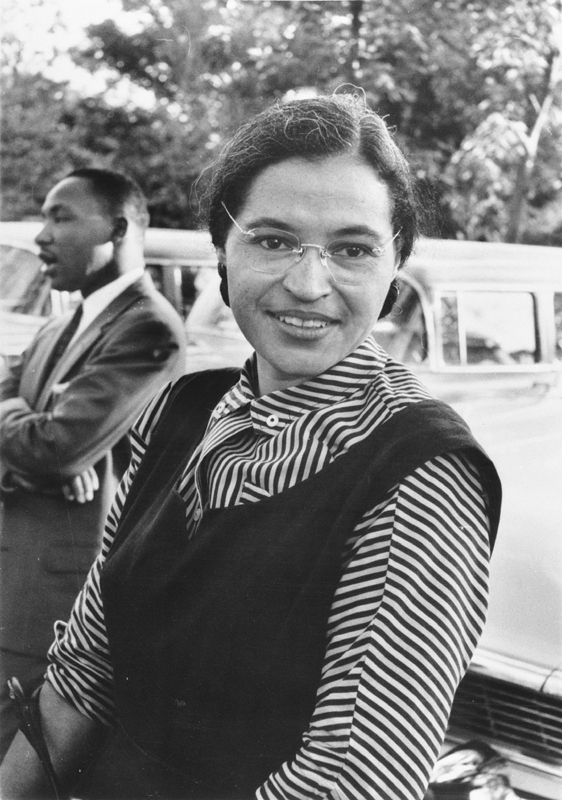Winner of the Fall 2016 StMU History Media Award for
Best Article in the Category of “People”
When one hears the name Rosa Parks, one is taken back in time to 1955, when a brave woman decided not to give up her seat. Rosa Parks was a woman who believed that the color of a person’s skin should not dictate the way a person is treated. Rosa Parks was a civil rights activist.

James McCauley, a skilled carpenter and stonemason, and Leona McCauley, a school teacher, were married on April 12, 1912, in Tuskegee, Alabama. Two months before their first anniversary, on February 4, 1913, in Tuskegee, Alabama they welcomed a daughter into their lives and named her Rosa Louise McCauley. On August 20, 1925 the McCauleys welcomed their son, Sylvester McCauley, into their family.1 The McCauley family decided to move to Abbeville, Alabama where they lived with James’s parents, sharing a bedroom with a large extended family. Rosa’s mother grew tired of the living arrangements and without her husband James around to support the family, she made the decision to leave. In 1917, when Rosa was only 4 years old, Leona took her two young children and moved back to Pine Level, Alabama where she and the children stayed with her parents. Rosa saw her father a year later when she was five and then again when she was an adult and married.2
Rosa received most of her education from her mother and grandfather as a little girl. In 1924, when Rosa was eleven years old, her mother enrolled her in the Montgomery Industrial School for Girls. The school was for African American girls seeking education; they were taught by mostly white teachers. The school focused on the domestic sciences of cooking, sewing, and housekeeping. The white people of the town accused the teachers of teaching racial equality and referred to them as Yankee black lovers. The school was later burned down by the Ku Klux Klan as they grew more powerful.3 After the Montgomery Industrial School for Girls closed in 1928, fifteen year old Rosa attended Booker T. Washington High School for her ninth grade year. She wanted to be a teacher just like her mother, so for her tenth grade year Rosa attended Alabama State Teachers College for Negros. Sadly, she had to drop out of school and return to Pine Level, Alabama to care for her grandmother who had grown ill. When her grandmother died in 1929, Rosa was only 16 years old. She moved back to Montgomery and found her first job making men’s blue denim work shirts at a textile factory. Soon after beginning her job in the factory, Rosa was forced to leave in order to care for her mother who had also grown ill.4 Rosa spent her teenage years cleaning houses and taking in sewing jobs. In 1931, Rosa met Raymond Parks, who worked as a barber and was a member of the National Association for the Advancement of Colored People (NAACP).5 The two fell in love and in December 1932, Rosa and Raymond were married. Raymond encouraged his new bride to go back to school so as to finish her education. This meant so much to her, and so Rosa completed her studies and received her high school diploma in 1934.6

By 1943 all buses in the South had long been segregated and had followed an extensive set of rules set forth by the bus drivers. Montgomery, Alabama was no exception to the segregation. All the buses had thirty-six seats; the first ten were reserved for whites only, ten seats in the back of the bus were for African Americans, and as for the sixteen seats in-between, these were for the bus drivers to decide. African Americans were frequently forced to give up their seats for whites and the bus drivers imposed their own segregation rules through the use of guns they carried with them.7
In November of 1943 Rosa boarded a bus in Montgomery, Alabama. African Americans were typically required to enter the bus from the doors located near the back of the bus, but since the bus was extremely crowded, Rosa was forced to enter from the front doors of the bus. The bus driver demanded she get off the bus and enter through the back door and Rosa refused, standing her ground and explaining to the bus driver that since she was already on the bus there was no need for her to get off because the back of the bus was already at capacity and she would not be able to enter from the back. The bus driver began tugging at Rosa’s coat to push her off the bus and so she decided to not create more of a scene and exited the bus.8
On December 1, 1955, Rosa headed to work at the Montgomery Fair Department Store on the Cleveland Avenue bus to Court Square. It was a normal day for Rosa, working her regular shift, busy as usual.9 Once work was over, Rosa was tired; her body ached, her feet hurt and were swollen from standing all day. Rosa walked to Court Square to wait for her bus and as soon as the first bus came, she saw that it was packed and decided to wait for the next one. Once the second bus arrived Rosa entered the bus, paid, and sat in the racially neutral middle section behind the movable sign which read “colored.”10 At the third stop, a group of whites entered the bus and since the last front seats were taken, one was left standing. The bus driver turned around and looked at Rosa. Rosa was shocked to see that it was the same bus driver she had had a problem with twelve years earlier. The driver, James F. Blake, began to shout at the passengers, “Move ya’ll, I want those two seats,” meaning he wanted Rosa to give up her seat. Rosa did not get up and Blake went straight to Rosa demanding she give her seat up. When Rosa still would not comply he warned her that he would have her arrested, to which she simply replied, “You may do that.”11
Once police arrived, Rosa was arrested, handcuffed and taken to the police station. At the station, Rosa was finger printed, photographed and placed in a cell. While in jail Rosa was treated badly. She requested a drink of water and a police officer yelled out to her “for whites only.” She even requested to make one phone call and was ignored. After requesting several times to make her phone call, she was finally given approval and she phoned her husband. Edgar Daniel Nixon, an African-American civil rights leader, paid a one-hundred dollar bond to bail Rosa out of jail. Rosa worked with Nixon as a branch secretary. In speaking with Nixon about the incident, Rosa decided to file suit and make a civil rights case regarding Montgomery’s bus segregation.12 On the day of trial, December 5, 1955, African Americans in Montgomery boycotted the buses and Rosa was found guilty of breaking segregation laws.13 The boycott proved to be a large protest, and it led to the formation of the Montgomery Improvement Association (MIA).14 On November 13, 1956, the Supreme Court ruled that bus segregation was unconstitutional and the boycott ended on December 20, 1956.15 Rosa became known as the mother of the Civil Rights Movement.16

Rosa Parks traveled and supported civil rights events and causes and even wrote an autobiography, “Rosa Parks: My Story.” In 1999, for all her accomplishments and beliefs as a strong African American, Rosa was awarded the Congressional Gold Medal, which is the highest honor in the United States presented to a civilian.17 On October 24, 2005, at the age of 92, Rosa Parks passed away. She became the first woman in the nation’s history to lie in state at the U.S. Capitol.18
Rosa Parks left a major impact on America and made history. She stood up for what was right for herself and for the people, not because of the color of their skin but because she believed that everyone should be treated equally. She boarded a bus at the end of a long work day, tired and wanting to go home, not realizing that she would forever change segregation in America. Rosa Parks was a very noble woman and she left behind a legacy that will never be forgotten.
- Salem Press Biographical Encyclopedia, January 2016, s.v. “Rosa Parks,” by Tammy K. Baggett. ↵
- Douglas Brinkley, Rosa Parks (Penguin Group Penguin Putnam Inc., 2000), 20-21. ↵
- Brinkley, Rosa Parks, 28, 29, 36. ↵
- Brinkley, Rosa Parks, 36. ↵
- Brinkley, Rosa Parks, 38. ↵
- Salem Press Biographical Encyclopedia, January 2016, s.v. “Rosa Parks,” by Tammy K. Baggett. ↵
- Brinkley, Rosa Parks, 57. ↵
- Brinkley, Rosa Parks, 58-59. ↵
- Salem Press Biographical Encyclopedia, January 2016, s.v. “Rosa Parks,” by Tammy K. Baggett. ↵
- Brinkley, Rosa Parks, 105. ↵
- Brinkley, Rosa Parks, 106-107. ↵
- Brinkley, Rosa Parks, 73, 108, 109, 111, 113, 114. ↵
- Brinkley, Rosa Parks, 152. ↵
- Brinkley, Rosa Parks, 134. ↵
- Brinkley, Rosa Parks, 152, 170. ↵
- Rosa Parks: “The First Lady of Civil Rights,” Bill of Rights Institute, March 2, 2012, http://billofrightsinstitute.org/rosaparks/. (accessed November 7, 2016). ↵
- Salem Press Biographical Encyclopedia, January 2016, s.v. “Rosa Parks,” by Tammy K. Baggett. ↵
- Salem Press Biographical Encyclopedia, January 2016, s.v. “Rosa Parks,” by Tammy K. Baggett. ↵



79 comments
Sydney Hardeman
Rosa Parks was a brave hero. The Civil Rights Era was not long ago, and my grandfather has stories of dealing with segregation and racism growing up in the south. This was a great article and it was nice reading about Rosa Parks’ background as I did not know the details of her life prior to her not giving up her seat.
Vanessa Sanchez
Rosa Parks such an inspiration. She had proven to everyone what a strong women she is. She challenged the government for her believes. She knew something was wrong and instead of just following with what was expected she took the problem in her own hand and decided to do something about it. She is such an inspiration and a brave women. Amazing article I really appreciate to read about strong women’s story and to see how they have left their mark.
Raymond Munoz
I’m almost a hundred percent sure that when people think Civil Rights they immediately picture Martin Luther King Jr. and Rosa Parks. Their actions in the movement changed the lives of millions in their time and beyond. Ever since elementary school I have known of Rosa Parks and her place in history, so majority of this article is a refresher. Though, this article goes further to than a refresher, it broadens my perspective of what it means to be an activist. This article made me realize that Rosa Parks made big strides in the Civil Rights movement, but her and Martin Luther King Jr. were not the only existing activists and we must give credit where it is due.
Nathalie Herrera
There is a reason why Rosa Parks is talked about today. She was an activist on the civil rights movement and inspired/influenced many people during her time and even today. It is heartwarming to read stories such as her own and it teaches a valuable lesson for many generations up and coming. She shows great strength and courage by fighting for equality amongst others. Great read!
Brianna Ford
Rosa Parks did something that not many people would be brave enough to do during her time. She defied the law for the betterment of not only but for the rest of the African American community. Her rebellion sparked a revolution that changed our history for the betterment of individuals around the world. It was a pleasure reading this article and really liked the well descriptive details of her life. I look up to her and I am glad that she is seen as very important figure in American history. This article described Rosa Parks perfectly, and we need more articles like these.
Indhira Mata
It is funny to find out that Rosa Parks true reason of not giving up her seat was because she was absolutely tired from her job and couldn’t stand on her feet. After reading this article and seeing what she accomplished and did from this incident on the bus is outstanding. I bet she would have never thought this would happen at all. With the movements starting from her inspiration. She wasn’t just an African American figure, but also for females wanting to fight the civic movement too.
Jennifer Salas
I’ve been fascinated by Rosa Parks since I can remember. I admire her courage and how she did what was right when everyone else was telling her that it wasn’t her place. Not many people have the courage to fight for what’s right and this why Rosa Parks is an icon.This is a very important moment in the civil rights movement and this started a lot of conversations over racism. I don’t think Rosa Parks gets enough credit for everything she did during the civil rights movement. She did so much for the moment and she will forever be remembered.
Kathyleen Lauriano
It was amazing to read about such an influential person in history. Standing up for what she believed in really shows her character. She helped transform America into something great. She deserves all the recognition she gets. I admire her for all her hard work and courage. I believe this article really helped us understand who Rosa Parks really was. Great article!
Maria Esquivel
It is always a pleasure to read about the incredible Rosa Parks. I was captivated throughout the whole article and really appreciated the details of Rosa Parks life. After everything she had to endure, I am glad Rosa Parks ended up transforming America and making history. She impacted America greatly and I am glad that she stood up against racism, and fought for civil rights. Thank you for this article, it described Rosa Parks perfectly!
Jazmin Pizana
Great Article! It was very interesting to read about Rosa Park’s life before she was known for not giving up her seat on the back of the bus. She has faced many hardships in her life and at such early ages but she persevered and was made better for it. She’s very inspiring for her courage and bravery that resonates to this day.